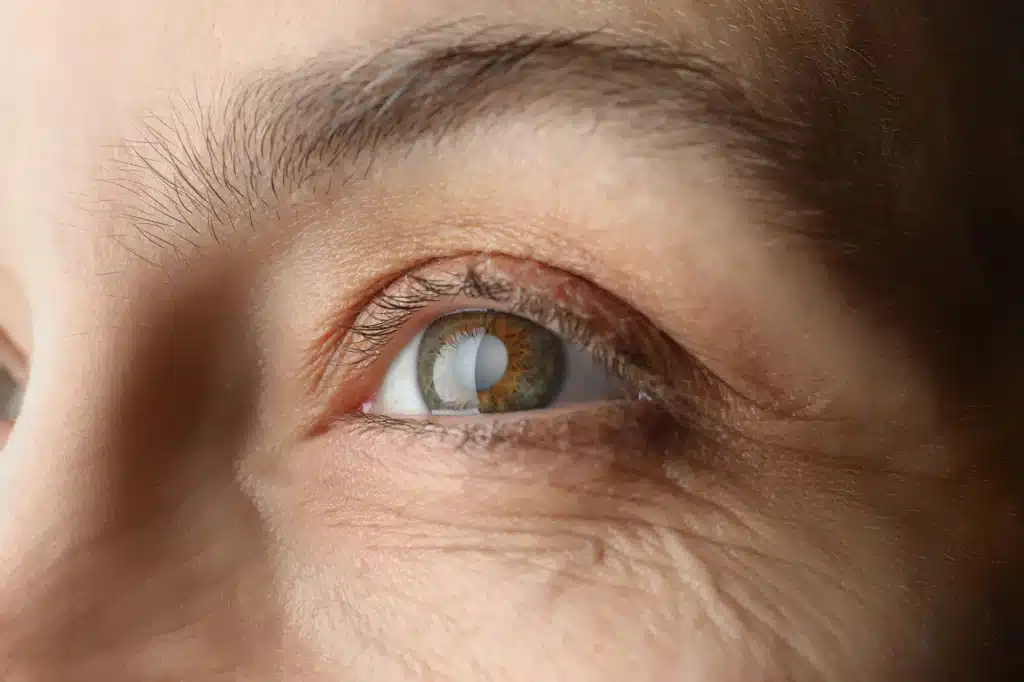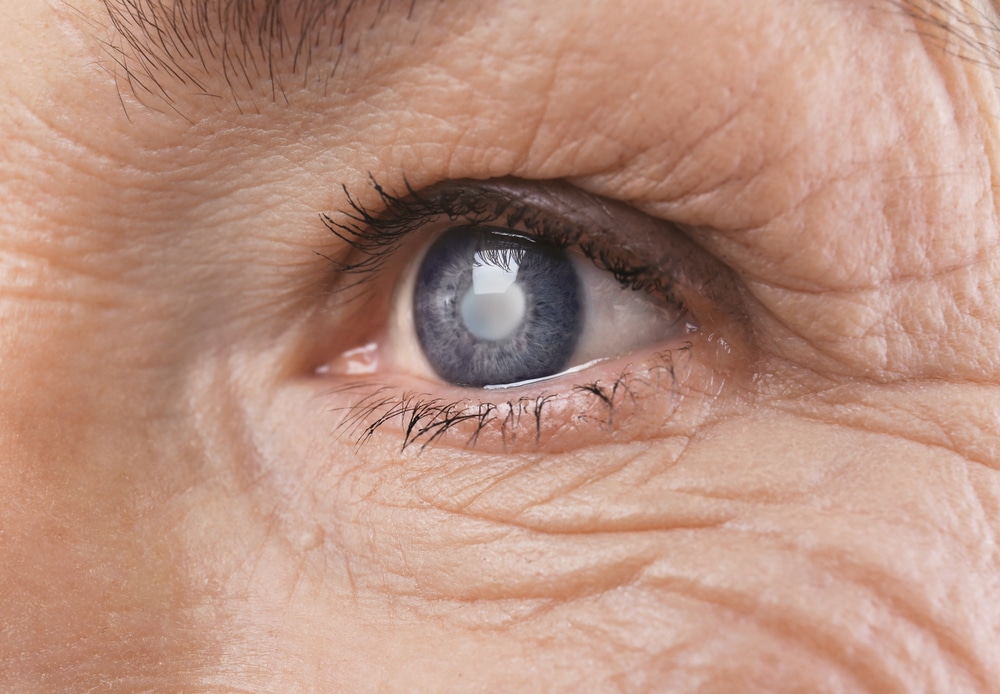Medically Reviewed by: Mark L. Mayo, M.D.
What Are the Early Signs of Cataracts?
When older patients come to us, they usually have a range of questions and concerns about their eyesight. Some wonder, “What’s the likelihood I’ll need glasses?” when what they really should be asking is “What are the early signs of cataracts?”
The American Academy of Ophthalmology states that 25 million Americans age 40 and up struggle with cataracts, and that half of Americans over the age of 75 will develop cataracts in their lifetime. Cataracts occur as a natural part of aging, but there are still things you can do to deter their advance.
Discover the early signs of cataracts and improve your chances of both delaying cataract onset and catching cataract growth in its earliest stages.
What are the causes of cataracts?
To better notice the first sign of cataracts, it’s important to know what exactly causes their formation. A cataract is caused by the breakdown of proteins in the lens of your eye. This breakdown, a natural product of aging, causes the blurred vision and/or vision loss of cataracts.
Your risk of developing cataracts can also increase under the following circumstances:
- Excessive exposure of the eye to the sun
- Eye trauma and/or eye surgery
- The use of corticosteroids
- Health issues such as diabetes, obesity, hypertension, and excessive smoking or consumption of alcohol
- Genetic disposition
It’s wise for individuals who have dealt or are dealing with these circumstances to schedule more frequent eye appointments than average, and to be vigilant for the early signs of cataracts.
Early signs of cataracts
Cataracts typically develop very slowly over time. Patients with cataracts in the early stages of development may not even realize they have cataracts until their doctor tells them. However, there are identifiable early signs of cataracts, including:
- Clouded, blurred vision: The appearance of cloudy or blurred vision is the most common and easily recognized early sign of cataracts. Many patients characterize this symptom as having blurred spots in their vision. Others can struggle with double vision in one or both of their eyes. Still others note that their cataracts can also make colors appear faded or yellowed.
- Halo formations around light: A cataract causes the light entering your eye to be diffracted (bend around the cataract) before it makes its way to your retina. This diffraction can cause halos to appear around light sources.
- Light sensitivity: People with early signs of cataracts can have multiple kinds of light sensitivities. These include both difficulty with seeing at night and performing activities in low light as well as difficulty or pain when there are particularly bright lights or glare.
- Rapid prescription changes: If you have eye examinations regularly (which you should!) and are beginning to get cataracts, then you and your doctor may notice rapid changes in your prescription strength. Your doctor should investigate if these changes are due to cataract formation, especially if you’re 40 years of age or older.
Note: If you’re on the lookout for early signs of cataracts, it’s also important to know the answer to these two additional questions:
- “What is the average age cataracts form?”
Cataracts tend to become problematic when people enter their 60s but can begin forming 10 to 20 years beforehand.
- “How quickly can cataracts develop?”
Cataracts typically develop very slowly but, as is discussed below, the rate at which your cataracts develop is ultimately determined by the type of cataract that is forming.
Types of cataracts
It’s not easy to tell what type of cataract you have by the early signs of cataracts alone. However, each type of cataract does have its own unique characteristics. Many cataracts are named by the location of the eye which they affect.
Slow-growing cataracts include:
- Nuclear cataracts (center of the lens): This type of cataract can be tricky, as it is known to sometimes temporarily improve your vision. Over time, however, nuclear cataracts cause yellowing or browning of the lens.
- Cortical cataracts (edges of the lens, the “lens cortex”): In cortical cataracts, white streaks or wedges form towards the outer edges of the eye and slowly extend inward.
- Some congenital cataracts: These cataracts can be caused by genetics, illnesses, or intrauterine trauma. Not all congenital cataracts affect vision.
Fast-growing cataracts include:
- Posterior subcapsular cataracts (back of the lens): These cataracts are known for forming more or less directly in the path of light entering your lens, making it difficult for those who develop them to read or handle bright light.
- Cataracts caused by other circumstances: Cataracts caused by diabetes (called diabetic snowflakes), trauma, radiation exposure, excessive smoking or alcohol, and the use of corticosteroids can develop at rates much quicker than other types of cataracts.
Nuclear and cortical cataracts typically affect older adults. Fast-growing cataracts can affect individuals of all ages, including the very young.
How can you prevent cataracts from getting worse?
If you want to lower your chances of having to watch out for the early signs of cataracts or if you want to prevent cataracts you already have from getting worse, there are steps you can take. Cataract prevention tactics can also simply keep your eyes healthier for longer. These include:
- Wearing sunglasses: Wearing sunglasses will cut down on how much exposure your eyes have to harmful UV rays. Make sure that the sunglasses you choose protect against ultraviolet B (UVB) rays, specifically.
- Quit smoking and drinking: When you quit smoking and drinking, your eye health and overall health will improve.
- Eat an eye-healthy diet: Fruits and vegetables have antioxidants that are crucial to eye health. Eating a variety of these foods regularly will likely lower your chances for cataracts.
- Schedule regular eye examinations: Regular eye examinations will help your doctors keep an eye (no pun intended) on your eye health. Call your eye doctor any time you notice what might be early signs of cataracts.
Cataract treatment at Eye Center of Texas
Recognize the early signs of cataracts in yourself or a loved one? Searching for “cataract doctors near me?” Eye Center of Texas is one of the top providers of cataract surgery in Houston. Over 275 eye doctors in the Houston area refer their patients to us for our high-quality patient care and state-of-the-art technology.
If you’re curious about the multifocal cataract lens or if catch yourself worrying “Is cataract surgery safe?” then rest assured that our nationally recognized surgeons are always available for an appointment. We are here to find the best, most personalized means of cataract prevention and cataract treatment for your eyes.
Call us at 713-797-1010 or contact us online to set up your appointment today
Related Resources:
Related Articles
Financing Options Available
Apply today to find a financing option that meets your needs.
Our Locations
Houston/Bellaire
6565 W. Loop S., Suite 650Bellaire, TX 77401
Medical Office:
713-797-1010
Medical Fax:
713-357-7276
LASIK/Near Vision:
Office: 713-395-1515
Fax: 713-357-7278
Pasadena
4415 Crenshaw RoadPasadena, TX 77504
Medical Office:
281-977-8800
Medical Fax:
281-977-8877
Sugar Land
15200 S.W. Freeway, Suite 130Sugar Land, TX 77478
Medical Office:
281-277-1010
Medical Fax:
281-277-4504
Clear Lake
455 E. Medical Center Blvd., Suite 110Webster, TX 77598
Medical Office:
281-332-1397
Medical Fax:
281-282-9152
Katy
Greenhouse Medical Plaza2051 Greenhouse Road, Suite 110
Houston, TX 77084
Medical Office:
713-797-1010
Medical Fax:
281-214-2971
The Woodlands/Conroe
100 Medical Center Blvd., Suite 118Conroe, TX 77304
Medical Office:
713-797-1010
Medical Fax:
936-647-1620


